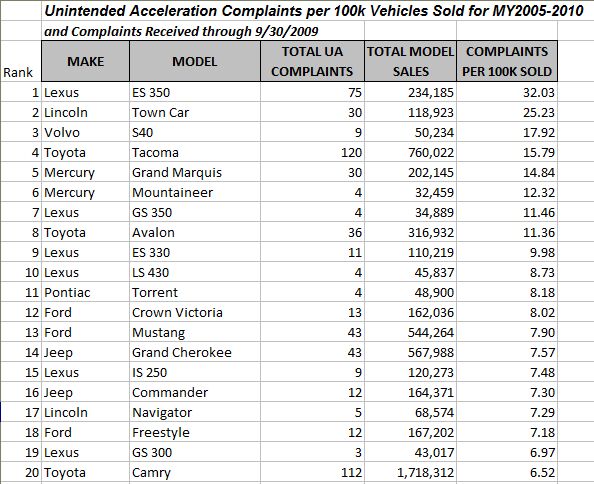NHTSA Data Dive 3: 117 Models Ranked By Rate Of UA Incidents

And the data beat goes on. I asked Edmunds if they had updated model information to filter out the spike of UA reports to NHTSA after the 9/29/09 Toyota mat recall in order to improve my attempt at coming up with a model-specific UA rate. Not only did they oblige, but they already did all the work! A big hat tip to Edmunds, who has taken a lead in the quest to make sense of the data as well as the whole UA fiasco.
A note of explanation from Edmunds:
Attached are the UA complaints against sales by Model for MY2005-2010 and complaints received through 9/30/2009. A couple things to note about our “complaints per 100k sold” measure: if the model sales was less than 30k, then we excluded it from the list and if the model sales was between 30k and 100k, then we extrapolated the complaints to 100k.
Furthermore, I removed a few cars that had very low UA reports, generally less than four. But I left other in with low numbers because they were essentially “twins” of other models (Fusion/Milan), in order to test how reliable and consistent they are between the. I’m happy to see that generally that is the case: (Grand Cherokee: 7.57; Commander: 7.30); (Fusion 2.91; Milan 3.18) (Vibe 2.85; Matrix 2.75).
Obviously, the same question as to the Panther triplets comes up: they’re all high, but by varying degrees. And of course the biggest on is the discrepancy between the ES 350 (32.03) and the very similar Camry (6.52).
One more minor note: the Lexus LS 430 has an old-time bottom-hinged accelerator pedal, so mat entrapment is not an issue with it. And it hasn’t been implicated with a sticky pedal either. So in its case it must either be human error or…
Finally, the next step would of course to cross tabulate both sides of this chart to specific model years, since awe saw in our previous post how much variation there is from year to year. And then…

More by Paul Niedermeyer
Latest Car Reviews
Read moreLatest Product Reviews
Read moreRecent Comments
- Lou_BC Blows me away that the cars pictured are just 2 door vehicles. How much space do you need to fully open them?
- Daniel J Isn't this sort of a bait and switch? I mean, many of these auto plants went to the south due to the lack of unions. I'd also be curious as how, at least in my own state, unions would work since the state is a right to work state, meaning employees can still work without being apart of the union.
- EBFlex No they shouldn’t. It would be signing their death warrant. The UAW is steadfast in moving as much production out of this country as possible
- Groza George The South is one of the few places in the U.S. where we still build cars. Unionizing Southern factories will speed up the move to Mexico.
- FreedMike I'd say that question is up to the southern auto workers. If I were in their shoes, I probably wouldn't if the wages/benefits were at at some kind of parity with unionized shops. But let's be clear here: the only thing keeping those wages/benefits at par IS the threat of unionization.





































Comments
Join the conversation
"Furthermore, I removed a few cars that had very low UA reports, generally less than four. But I left other in with low numbers because they were essentially “twins” of other models (Fusion/Milan), in order to test how reliable and consistent they are between the. I’m happy to see that generally that is the case: (Grand Cherokee: 7.57; Commander: 7.30); (Fusion 2.91; Milan 3.18) (Vibe 2.85; Matrix 2.75)." Then explain how the 300 is on the list, but not the Magnum, Challenger, or Charger.
Interesting stat about AT/MT cars having the same UA rate. Do MT drivers find that the clutch is also disabled in such occurrences?